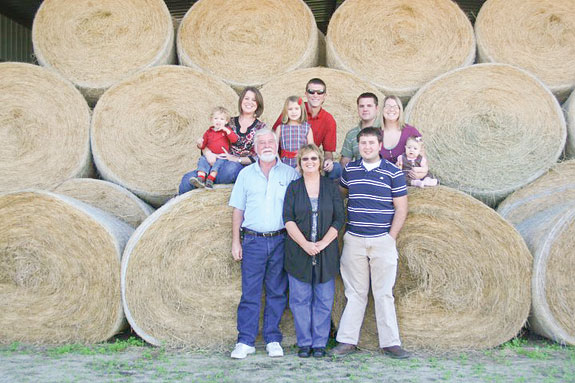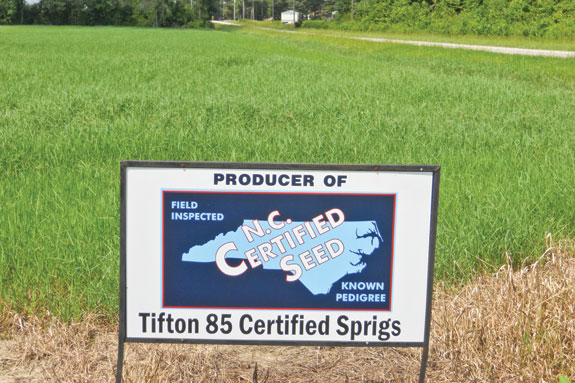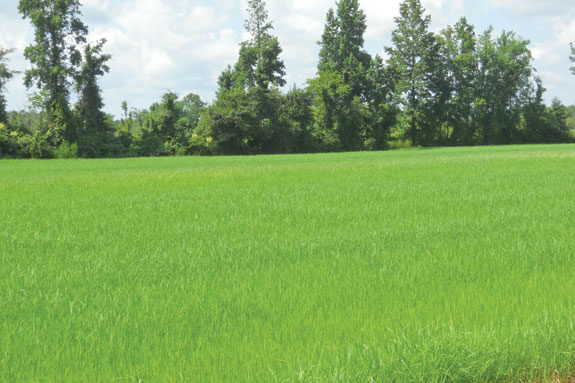Yes, you read that right, sprigging. Sprigging is done by a machine that creates a trench, about 1-2 inches deep, where sprigs are deposited.
Many of you have probably heard of a sprig before, but what exactly is it? Sprigs are essentially roots with soil unattached, and they are planted in prepared soil.
They include stolons, which run above-ground and rhizomes, which run underground. The sprigs are capable of developing a larger root system and a new plant at each joint.
Why spend time sprigging rather than traditional seed planting? The reason sprigging exists is not only because sprigging produces high-quality forage, but also because some varieties can only be planted by this method.
Bermudagrass varieties produce very small amounts – if any – seed. Usually the seeds are not even viable.
Douglas Heath has planted over 20,000 acres of sprigs in North Carolina, but it’s not limited to that state.
According to Heath, you can find sprigging across the southern U.S. To put sprig planting in another perspective, you can find them from Virginia down and across the southern states all the way to California.
“Sprigs come in a number of different varieties and they produce a high-quality product that you just don’t see in a lot of seed varieties,” Heath says. He plants varieties of Bermudagrass sprigs.
According to Heath, Bermudagrass is a warm-season grass, native to southeast Africa, used for pasture and hay throughout the southern U.S. Bermudagrass is deep-rooted, sod-forming grass that spreads by stolons and rhizomes and grows to a height of 15-24 inches.
It also serves as the forage used for many livestock operations because of its high forage production capability.
“These sprig varieties are high-quality and perform well, and a lot of seed varieties are just not up to this level of quality yet,” Heath says.
Prior to planting, Heath uses a machine that tills the sprigs onto a conveyor belt and shakes the soil off of them.
Then the sprigs are sent on down the conveyor belt into loading trucks or trailers. For quality assurance, Heath grows and digs his own sprigs.
For planting the sprigs, Heath uses a different machine. “I use a five-row Bermuda King planter, which drops sprigs in 24-inch rows and covers them with a packer wheel,” Heath says. According to Heath, the packer wheels eliminate air pockets in the soil and ensure good “sprig-to-soil” contact.

Heath pitchforks his sprigs into the planter by hand with his son, Canyon. Then they drive the tractor to the land scheduled for planting after the soil has been properly prepared.
According to Heath, five to six acres of sprigs can be planted per hour with the five-row Bermuda King planter.
One producer in eastern North Carolina Heath plants sprigs for, Anthony Lee, says, “If you listen to Doug Heath, then your hay is going to grow and it’s going to grow well.”
Heath planted 80 to 100 acres of sprigging for Lee, including about 30 acres of Tifton 44. Lee says he got about 93 round bales out of the grass and he still had more opportunities to cut.
Marty Ausley, another producer in North Carolina, also had sprigs planted by Heath. “Heath planted about 35 acres of Midland 99 for me and he did a great job,” Ausley says. According to Ausley, he can cut his Midland 99 four or more times per year with great results.
“There is a high demand for the product because of its high nutrient and protein percentages,” says Ausley.
Heath has been sprigging for 20 years. “We saw the hog industry was growing years ago and they had to have the hay field to put their hog waste on, and that’s how we got started,” Heath says.
According to Heath, he knew he had a business from the start, working for big hog companies. He also sprigged for municipalities to pump their wastewater on.
Heath plants five different types of Bermudagrass sprigs. Coastal, Midland 99 certified, Ozark certified, Tifton 44 and Tifton 85 certified.
In fact, the Oklahoma Agricultural Experiment Station in cooperation with the Samuel Roberts Noble Foundation, the USDA – Agricultural Research Service and the Arkansas, Kansas and Missouri Agricultural Experiment Stations originally released Heath’s Midland 99 variety.
Midland 99 certified
Midland 99 is a dependable, highly productive variety that is widely adapted to the upper South.
The leaves of Midland 99 typically produce seed heads later and less efficiently than Midland, Tifton 44 and Greenfield. However, very few seeds are produced in the heads.
Coastal
Coastal grows tall and produces seed heads that rarely contain viable seed. Coastal also shows good resistance to leaf spot and root spot nematodes.
This variety is also adapted to well-drained soils of the coastal plains and piedmont.
Ozark
Ozark’s superior cold tolerance, stand persistence, adaptation, production and quality make it unique among released Bermudagrass varieties.
Ozark, like Midland, Midland 99 and Tifton 44, is relatively upright and tall-growing in comparison to Greenfield.
Its excellent stand persistence in humid environments, as well as field observations, suggest that it has good resistance to diseases that may cause stand thinning.
In almost every trial conducted it has yielded as much or more forage than any other variety.
Tifton 44
Tifton 44 is darker green, has finer stems that cure faster when cut for hay, has more rhizomes, is a little shorter, makes a denser sod and is more winter-hardy than other Bermudas tested.
Tifton 44 starts growth earlier in the spring and is more resistant to foliage diseases. Tifton 44 also has large roots and can be planted as early as March.

Tifton 85 certified
According to Heath, Tifton 85 is the fastest-establishing bermuda. The stolons can grow three inches a day and develop roots and a plant at each node when soil moisture and growing conditions are favorable.
Tifton 85 planting dates are generally April through June.
Tifton 85 has averaged 26 percent more dry matter and was 11 percent more digestible than Coastal in small plot tests. It also has proven cattle gain faster on Tifton 85. Winter-hardiness is still undetermined, but Tifton 85 is believed to be cold-sensitive. FG
PHOTOS:
Top: The Oklahoma Ag Experiment Station originally released Heath’s Midland 99 variety.
Bottom: Douglas Heath has planted over 20,000 acres of sprigs in North Carolina. Photos courtesy of the Heath family.










